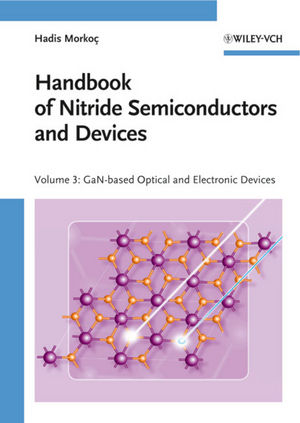
Handbook of Nitride Semiconductors and Devices
Wiley-VCH (Verlag)
978-3-527-40839-9 (ISBN)
- Titel ist leider vergriffen;
keine Neuauflage - Artikel merken
Dieser dritte Band des herausragenden Handbuches zu sämtlichen Eigenschaften von Nitrid-Halbleitern widmet sich schwerpunktmäßig den Anwendungsfeldern LED (Leuchtdioden), Laser, FET (Feldeffekttransistoren), HBT (Heterojunction Bipolar Transistors) und Detektoren.
Hadis Morkoç received his Ph.D. degree in Electrical Engineering from Cornell University. From 1978 to 1997 he was with the University of Illinois, then joined the newly established School of Engineering at the Virginia Commonwealth University in Richmond. He and his group have been responsible for a number of advancements in GaN and devices based on them. Professor Morkoç has authored several books and numerous book chapters and articles. He serves or has served as a consultant to some 20 major industrial laboratories. Professor Morkoç is, among others, a Fellow of the American Physical Society, the Material Research Society, and of the Optical Society of America.
Preface XI
Color Tables XIX
1 Light-Emitting Diodes and Lighting 1
Introduction 1
1.1 Current-Conduction Mechanism in LED-Like Structures 4
1.2 Optical Output Power 6
1.3 Losses and Efficiency 7
1.4 Current Crowding 11
1.5 Packaging 15
1.6 Perception of Visible Light and Color 22
1.7 Visible-Light Terminology 27
1.7.1 Luminous Efficacy 29
1.7.2 Chromaticity Coordinates and Color Temperature 30
1.8 Inroads by LEDs 33
1.9 Nitride LED Performance 37
1.9.1 LEDs on Sapphire Substrates 38
1.9.1.1 Blue and Green LEDs 40
1.9.1.2 Amber LEDs 47
1.9.1.3 UV LEDs 48
1.9.1.4 Resonant Cavity-Enhanced LED 55
1.9.1.5 Effect of Threading Dislocation on LEDs 57
1.9.2 LEDs on SiC Substrates 60
1.9.3 LEDs on Si Substrates 61
1.9.4 LEDs Utilizing Rare Earth Transitions 62
1.10 On the Nature of Light Emission in Nitride-Based LEDs 64
1.10.1 Pressure Dependence of Spectra 65
1.10.2 Current and Temperature Dependence of Spectra 67
1.11 LED Degradation 70
1.12 LED Efficiency 76
1.13 Monochrome Applications of LEDs 82
1.14 Luminescence Conversion and White-Light Generation with Nitride LEDs 85
1.14.1 Color as Related to White-Light LEDs 87
1.14.2 Color Rendering Index 88
1.15 Approaches to White-Light Generation 91
1.15.1 White Light from Three-Chip LEDs 91
1.15.2 White Light from Four-Chip LEDs 97
1.15.3 Combining LEDs and Phosphor(s) 100
1.15.4 Other Photon Conversion Schemes 111
1.16 Toward the White-Light Applications 114
1.17 Organic/Polymeric LEDs (OLED, PLED) 122
1.17.1 OLED Structures 124
1.17.2 Charge and Energy Transport Fundamentals 132
1.17.3 Properties of Organic Crystals 135
1.17.4 Light Emission Dynamics 139
1.17.4.1 Nonradiative Recombination 143
1.17.4.2 Internal Conversion 143
1.17.4.3 Intersystem Crossing 143
1.17.4.4 Singlet Fission 143
1.17.4.5 Aggregation and Davydov Splitting 144
1.17.4.6 Charge-Transfer Excitons 145
1.17.5 OLED Devices 146
1.17.5.1 White OLEDs 147
1.17.5.2 Displays 151
1.17.6 Lighting with OLEDs 155
References 157
2 Semiconductor Lasers 169
Introduction 169
2.1 A Primer to the Principles of Lasers 172
2.2 Waveguiding 175
2.2.1 Refractive Index of GaN and AlGaN 176
2.2.2 Refractive Index of InGaN 180
2.2.3 Analytical Solution to the Waveguide Problem 180
2.2.4 Numerical Solution of the Waveguide Problem 184
2.2.5 Far-Field Pattern 191
2.3 Loss, Threshold, and Cavity Modes 194
2.4 Optical Gain 196
2.4.1 A Glossary for Semiconductor Lasers 208
2.4.2 Optical Gain in Bulk Layers: A Semiconductor Approach 215
2.4.2.1 Relating Absorption Rate to Absorption Coefficient 216
2.4.2.2 Relating Stimulated Emission Rate to Absorption Coefficient 217
2.4.2.3 Relating Spontaneous Emission Rate to Absorption Coefficient 217
2.4.2.4 Fermi.s Golden Rule, Stimulated and Spontaneous Emission Rates, and Absorption Coefficient Within the k-Selection Rule 217
2.4.3 Gain in Quantum Wells 231
2.5 Coulombic Effects 235
2.6 Numerical Gain Calculations for GaN 239
2.6.1 Optical Gain in Bulk GaN 239
2.6.2 Gain in GaN Quantum Wells 241
2.6.3 Gain Calculations in Wz GaN Q Wells Without Strain 241
2.6.4 Gain Calculations in Wz Q Wells with Strain 241
2.6.5 Gain in ZB Q Wells Without Strain 244
2.6.6 Gain in ZB Q Wells with Strain 245
2.6.6.1 Pathways Through Excitons and Localized States 246
2.6.7 Measurement of Gain in Nitride Lasers 257
2.6.7.1 Gain Measurement via Optical Pumping 258
2.6.7.2 Gain Measurement via Electrical Injection (Pump) and Optical Probe Method 261
2.7 Threshold Current 262
2.8 Analysis of Injection Lasers with Simplifying Assumptions 263
2.9 Recombination Lifetime 264
2.10 Quantum Efficiency 267
2.11 GaN-Based LD Design and Performance 267
2.12 Gain Spectra of InGaN Injection Lasers 280
2.13 Near-UV Lasers 290
2.14 Reflector Stacks and Vertical Cavity
| Reihe/Serie | Handbook of Nitride Semiconductors and Devices ; 3 |
|---|---|
| Sprache | englisch |
| Maße | 170 x 240 mm |
| Gewicht | 1826 g |
| Themenwelt | Technik ► Elektrotechnik / Energietechnik |
| Schlagworte | Electrical & Electronics Engineering • Electrical & Electronics Engineering • Elektrotechnik u. Elektronik • Halbleiter • Halbleiterphysik • Nitride • Physics • Physik • Semiconductor physics • semiconductors |
| ISBN-10 | 3-527-40839-8 / 3527408398 |
| ISBN-13 | 978-3-527-40839-9 / 9783527408399 |
| Zustand | Neuware |
| Haben Sie eine Frage zum Produkt? |
aus dem Bereich


